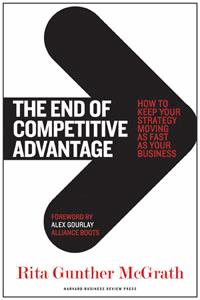Competitive Advantage Is Not What It Used To Be
By Rita Gunther McGrath, Globally Recognized Thought Leader
 The pharmaceutical and healthcare industries are at a crossroads, with the traditional business models experiencing what some have described as “fatigue.” Like many other industries facing profound shifts, this creates the imperative to bring together the disparate fields of competitive strategy, innovation, and organizational change.
The pharmaceutical and healthcare industries are at a crossroads, with the traditional business models experiencing what some have described as “fatigue.” Like many other industries facing profound shifts, this creates the imperative to bring together the disparate fields of competitive strategy, innovation, and organizational change.
We need to add new frameworks and tools for practicing strategy to the well-entrenched ones many of us are still using, because the boundary conditions have utterly changed. What use is a five-forces analysis, for instance, when firms can be both buyers and suppliers simultaneously? How valuable is industry analysis when the most significant competition crosses industry lines?
THE NEW STRATEGY PLAYBOOK
The implications of all these ideas come together in what I refer to as a new playbook for strategy. Strategy today needs to be based on the idea of transient competitive advantage — that is, where you compete, how you compete, and how you win is very different when competitive advantage is no longer sustainable for a long period of time. The new playbook encompasses:
- Continuous organizational reconfiguration so the organization doesn’t get stuck in bureaucracy
- Healthy disengagement when the time comes
- Deft resource allocation so people and funds go to their best opportunities rather than being held hostage in often-competing organizational silos
- Innovation as a genuine proficiency, throughout the organization
- Courageous leaders who realize you can’t manage a secret
- Talent strategies that fit a “tour-of-duty” world
The good news is that we have developed a number of new tools and frameworks that are suitable for this higher-velocity, uncertain environment.
NEW TOOLS FOR INNOVATION
For instance, when it comes to assessing and selecting projects, we know that including option value (the value of a right to make a future choice) can counter the pervasive anti-innovation bias of innovation killing tools such as net present value. It also allows you to invest in the future without risking massive losses.
We also understand much better how to use intelligent failure to facilitate learning. In fact, rather than calling them failures, I’d encourage you to think of them as investments in learning, much in the same way we invest in experiments in science. Even when a hypothesis is not borne out, it teaches us what avenues are likely not to be fruitful, which has value.
Opportunity recognition is a skill that can be enhanced and developed in a systematic way, as can the other elements of innovation proficiency, such as incubating new projects and accelerating their growth. Although the old competitive rules in the life sciences and healthcare spaces are changing, with those changes also comes tremendous opportunities — if leaders learn to capitalize on them.

Rita Gunther McGrath is a globally recognized thought leader who focuses on leading innovation and growth, working with senior executives to think strategically, even in today’s rapidly changing and volatile environments.
She is the author of the book “The End of Competitive Advantage.”
